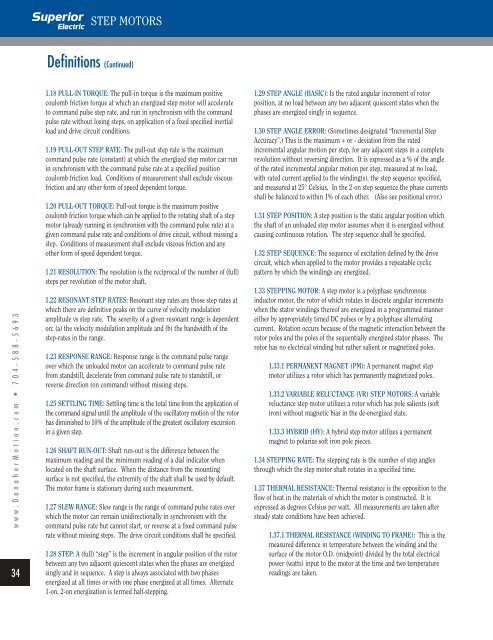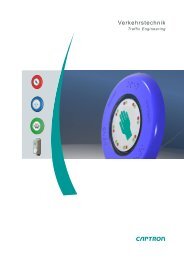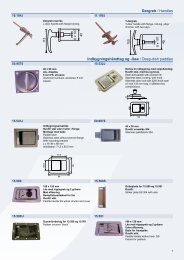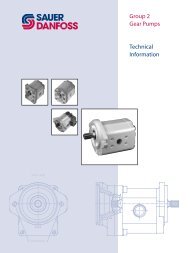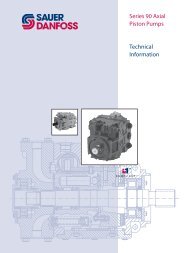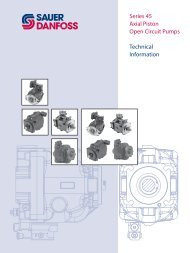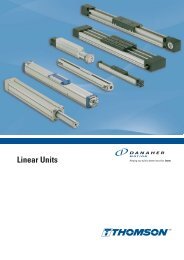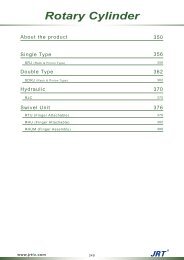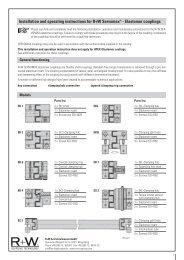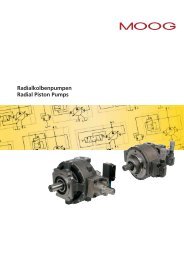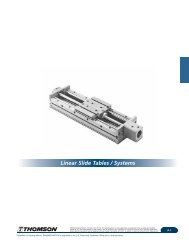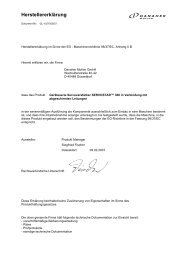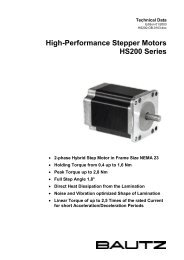Create successful ePaper yourself
Turn your PDF publications into a flip-book with our unique Google optimized e-Paper software.
www.DanaherMotion.com • 704-588-5693<br />
34<br />
STEP MOTORS<br />
Definitions (Continued)<br />
1.18 PULL-IN TORQUE: The pull-in torque is the maximum positive<br />
coulomb friction torque at which an energized <strong>step</strong> motor will accelerate<br />
to command pulse <strong>step</strong> rate, and run in synchronism with the command<br />
pulse rate without losing <strong>step</strong>s, on application of a fixed specified inertial<br />
load and drive circuit conditions.<br />
1.19 PULL-OUT STEP RATE: The pull-out <strong>step</strong> rate is the maximum<br />
command pulse rate (constant) at which the energized <strong>step</strong> motor can run<br />
in synchronism with the command pulse rate at a specified position<br />
coulomb friction load. Conditions of measurement shall exclude viscous<br />
friction and any other form of speed dependent torque.<br />
1.20 PULL-OUT TORQUE: Pull-out torque is the maximum positive<br />
coulomb friction torque which can be applied to the rotating shaft of a <strong>step</strong><br />
motor (already running in synchronism with the command pulse rate) at a<br />
given command pulse rate and conditions of drive circuit, without missing a<br />
<strong>step</strong>. Conditions of measurement shall exclude viscous friction and any<br />
other form of speed dependent torque.<br />
1.21 RESOLUTION: The resolution is the reciprocal of the number of (full)<br />
<strong>step</strong>s per revolution of the motor shaft.<br />
1.22 RESONANT STEP RATES: Resonant <strong>step</strong> rates are those <strong>step</strong> rates at<br />
which there are definitive peaks on the curve of velocity modulation<br />
amplitude vs <strong>step</strong> rate. The severity of a given resonant range is dependent<br />
on: (a) the velocity modulation amplitude and (b) the bandwidth of the<br />
<strong>step</strong>-rates in the range.<br />
1.23 RESPONSE RANGE: Response range is the command pulse range<br />
over which the unloaded motor can accelerate to command pulse rate<br />
from standstill, decelerate from command pulse rate to standstill, or<br />
reverse direction (on command) without missing <strong>step</strong>s.<br />
1.25 SETTLING TIME: Settling time is the total time from the application of<br />
the command signal until the amplitude of the oscillatory motion of the rotor<br />
has diminished to 10% of the amplitude of the greatest oscillatory excursion<br />
in a given <strong>step</strong>.<br />
1.26 SHAFT RUN-OUT: Shaft run-out is the difference between the<br />
maximum reading and the minimum reading of a dial indicator when<br />
located on the shaft surface. When the distance from the mounting<br />
surface is not specified, the extremity of the shaft shall be used by default.<br />
The motor frame is stationary during such measurement.<br />
1.27 SLEW RANGE: Slew range is the range of command pulse rates over<br />
which the motor can remain unidirectionally in synchronism with the<br />
command pulse rate but cannot start, or reverse at a fixed command pulse<br />
rate without missing <strong>step</strong>s. The drive circuit conditions shall be specified.<br />
1.28 STEP: A (full) “<strong>step</strong>” is the increment in angular position of the rotor<br />
between any two adjacent quiescent states when the phases are energized<br />
singly and in sequence. A <strong>step</strong> is always associated with two phases<br />
energized at all times or with one phase energized at all times. Alternate<br />
1-on, 2-on energization is termed half-<strong>step</strong>ping.<br />
1.29 STEP ANGLE (BASIC): Is the rated angular increment of rotor<br />
position, at no load between any two adjacent quiescent states when the<br />
phases are energized singly in sequence.<br />
1.30 STEP ANGLE ERROR: (Sometimes designated “Incremental Step<br />
Accuracy”.) This is the maximum + or - deviation from the rated<br />
incremental angular motion per <strong>step</strong>, for any adjacent <strong>step</strong>s in a complete<br />
revolution without reversing direction. It is expressed as a % of the angle<br />
of the rated incremental angular motion per <strong>step</strong>, measured at no load,<br />
with rated current applied to the winding(s), the <strong>step</strong> sequence specified,<br />
and measured at 25° Celsius. In the 2-on <strong>step</strong> sequence the phase currents<br />
shall be balanced to within 1% of each other. (Also see positional error.)<br />
1.31 STEP POSITION: A <strong>step</strong> position is the static angular position which<br />
the shaft of an unloaded <strong>step</strong> motor assumes when it is energized without<br />
causing continuous rotation. The <strong>step</strong> sequence shall be specified.<br />
1.32 STEP SEQUENCE: The sequence of excitation defined by the drive<br />
circuit, which when applied to the motor provides a repeatable cyclic<br />
pattern by which the windings are energized.<br />
1.33 STEPPING MOTOR: A <strong>step</strong> motor is a polyphase synchronous<br />
inductor motor, the rotor of which rotates in discrete angular increments<br />
when the stator windings thereof are energized in a programmed manner<br />
either by appropriately timed DC pulses or by a polyphase alternating<br />
current. Rotation occurs because of the magnetic interaction between the<br />
rotor poles and the poles of the sequentially energized stator phases. The<br />
rotor has no electrical winding but rather salient or magnetized poles.<br />
1.33.1 PERMANENT MAGNET (PM): A permanent magnet <strong>step</strong><br />
motor utilizes a rotor which has permanently magnetized poles.<br />
1.33.2 VARIABLE RELUCTANCE (VR) STEP MOTORS: A variable<br />
reluctance <strong>step</strong> motor utilizes a rotor which has pole salients (soft<br />
iron) without magnetic bias in the de-energized state.<br />
1.33.3 HYBRID (HY): A hybrid <strong>step</strong> motor utilizes a permanent<br />
magnet to polarize soft iron pole pieces.<br />
1.34 STEPPING RATE: The <strong>step</strong>ping rate is the number of <strong>step</strong> angles<br />
through which the <strong>step</strong> motor shaft rotates in a specified time.<br />
1.37 THERMAL RESISTANCE: Thermal resistance is the opposition to the<br />
flow of heat in the materials of which the motor is constructed. It is<br />
expressed as degrees Celsius per watt. All measurements are taken after<br />
steady state conditions have been achieved.<br />
1.37.1 THERMAL RESISTANCE (WINDING TO FRAME): This is the<br />
measured difference in temperature between the winding and the<br />
surface of the motor O.D. (midpoint) divided by the total electrical<br />
power (watts) input to the motor at the time and two temperature<br />
readings are taken.


